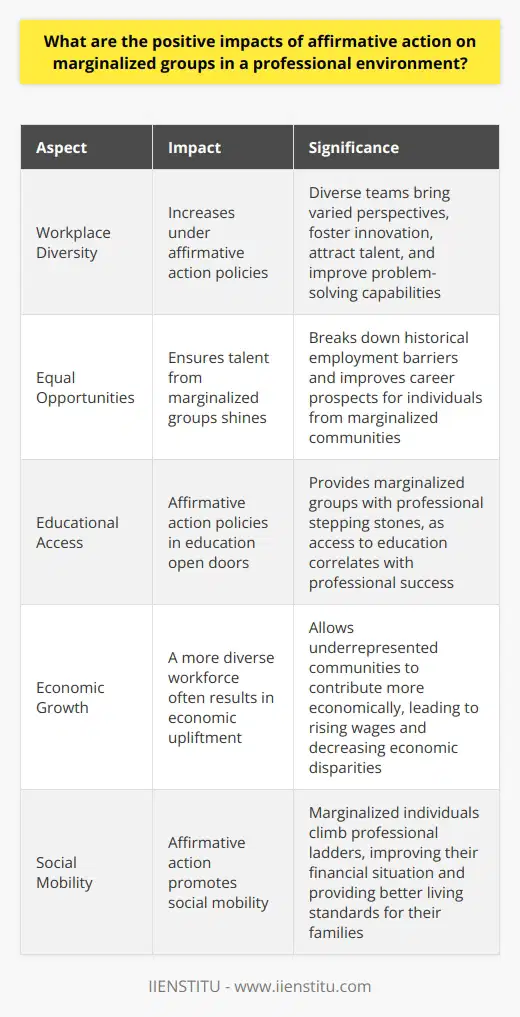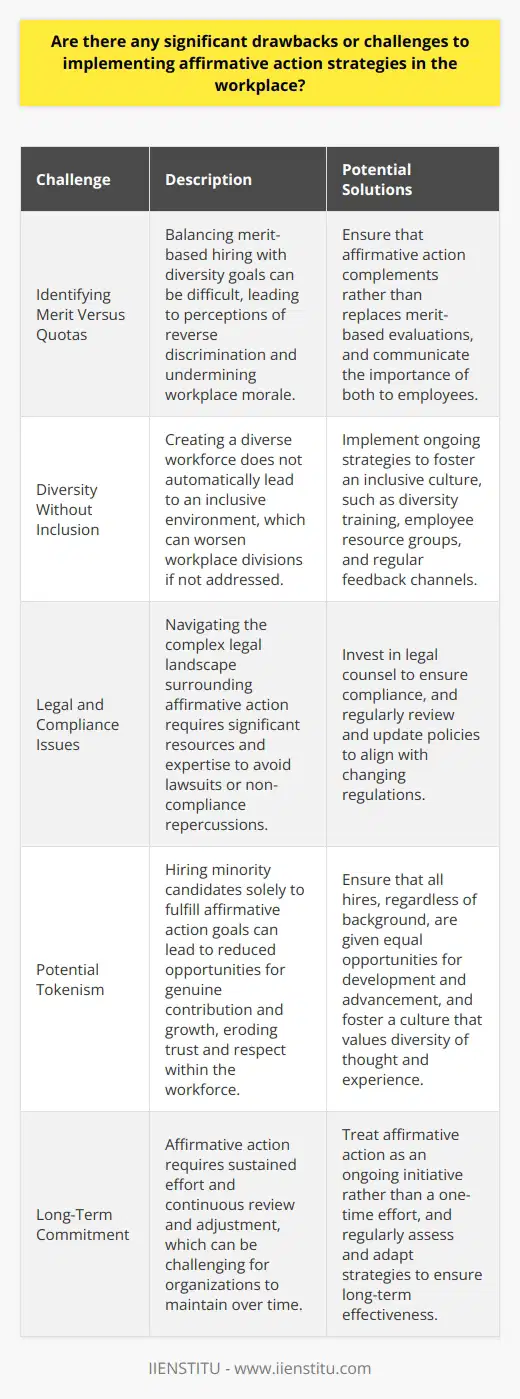
The concept of affirmative action has long been a subject for fervent debate, discussion, and litigation. Rooted in a desire to overcome past discrimination and promote diversity, affirmative action policies aim to provide equal opportunities to underrepresented groups.
This article seeks to explore the various facets of affirmative action with an emphasis on its role in fostering workplace diversity. By offering a comprehensive account enriched with historical context, an outline of arguments, and illustrative examples, we invite an informed reflection on the nuances of affirmative action within modern society.
🔊 Ready for an auditory reading experience? Just click the 'Play' button right below this text and immerse yourself in our captivating audio version. Ideal for those who prefer listening to stories, or for times when you're multitasking. Engage with our content effortlessly - one simple click is all it takes to transform your reading into listening!
The History of Affirmative Action
Origin of Affirmative Action in the United States: The seeds of affirmative action were sown during the tumultuous era of the Civil Rights Movement. As minorities and women strived for equality under the law, these efforts necessitated policies that would not only remove existing barriers but also actively correct disparities. The term itself was first coined by President John F. Kennedy in 1961 with Executive Order 10925, which demanded that government contractors "take affirmative action to ensure that applicants are employed, and employees are treated without regard to their race, creed, color, or national origin." Thus, the movement for a fairer and more equitable society began its shift from the streets to the structural policies that govern institutions.
Major amendments and changes over the years: Through the following decades, affirmative action policies evolved, often reflecting the political and social climate of the times. Expansion during President Johnson's tenure to include education and other sectors was a significant milestone. Over time, however, these policies would be narrowed by Supreme Court decisions, which scrutinized their implementation, seeking to balance the need for diversity with individual rights. Furthermore, state-level actions, such as California’s Proposition 209, have added layers of complexity by banning consideration of race in public employment, education, and contracting.
Affirmative Action policies in other parts of the world: Outside the United States, affirmative action, or positive discrimination as it is sometimes known, has been adopted in various forms. For instance, India's reservation system offers opportunities for Scheduled Castes and Tribes, while Brazil's quota system seeks to rectify the racial imbalances in higher education and government jobs. Despite differing approaches, the underlying principle remains consistent: fostering a more inclusive society where past injustices no longer dictate future opportunities.
The Arguments For and Against Affirmative Action
Advocates' perspective on Affirmative Action: Proponents of affirmative action assert that such policies are crucial in promoting workplace diversity. They argue that diversity enhances the quality of ideas, problem-solving, and represents an ethical commitment to equality. Affirmative action also serves as redress for historical injustices by providing marginalized communities with opportunities that have been systematically denied. Furthermore, supporters contend that creating a level playing field for minorities in hiring and promotion practices is not only a moral imperative but also a beneficial strategy for organizations seeking a wide array of talents and perspectives.
Critics' perspective on Affirmative Action: Conversely, critics claim that affirmative action can lead to a form of reverse discrimination, unfairly disadvantaging those who do not belong to the targeted underrepresented groups. By focusing on group identity, detractors believe that these policies may overlook individual merit and qualifications. In addition, there are concerns regarding the fairness across generations – while seeking to remedy past discrimination, affirmative action might impose consequences on individuals who have no responsibility for historical inequities.
Counterpoint: Yet, the contrasting viewpoints reflect a deeper societal struggle to reconcile a commitment to equal opportunity with the variable definitions of fairness and justice. As we explore affirmative action's various applications, these arguments underline the ongoing dialogue about how best to achieve a just and equitable society.
Affirmative Action in Different Spheres
Affirmative Action in Education: In the realm of higher education, affirmative action has manifested primarily through college admissions processes, where institutions consider race as one of many factors to create a diverse student body. Scholarships and funding earmarked for underrepresented minorities serve as additional measures to mitigate the financial barriers that could otherwise limit access to education for these groups.
Affirmative Action in the Workplace: Turning to the professional environment, the workplace application of affirmative action can be seen in recruitment and hiring initiatives. Various organizations and companies use hr certification course programs to train hiring managers and recruiters on understanding and implementing affirmative action, while online courses educate employees about diversity and inclusiveness. Career advancement initiatives also play a crucial role by providing mentorship and development opportunities specifically for employees from underrepresented backgrounds.
Affirmative Action in Politics and Governance: In the political sphere, affirmative action has influenced the representation of minorities in elected offices and government services. Quotas and reserved positions are controversial yet at times an effective strategy in amplifying the voices of those historically marginalized. Throughout various sectors, affirmative action interplays with societal values and goals, evolving to meet the need for equity and representation.
Workplace Harassment: Effects, Legal Issues and Prevention Strategies
Curbing Workplace Illiteracy: A Business and School Partnership
Case Studies illustrating Affirmative Action
Affirmative Action success stories: There are numerous instances where affirmative action policies have successfully created more inclusive environments. Universities with diverse student bodies often report richer educational experiences for all students, and businesses that prioritize diversity in their workforce recognize the innovation and broader market appeal it brings. These success stories offer tangible benefits that can inspire further commitment to affirmative action policies.
Controversies arising from Affirmative Action policies: Nevertheless, these policies are not without controversies. High-profile legal cases in the United States, such as Fisher v. University of Texas, capture the ongoing conflict surrounding the application of affirmative action in college admissions. Such cases highlight the fine line between providing opportunities to underrepresented groups and adhering to the principles of individual assessment based on merit.
The Future of Affirmative Action
Current debates and policy adjustments: As we navigate into the future, debates about the effectiveness and fairness of affirmative action continue to rage on. These discussions lead to policy adjustments and legal challenges that reflect the changing attitudes towards race, gender, and inequality. Some institutions attempt to find race-neutral alternatives to achieve diversity, while others reaffirm their commitment to traditional affirmative action methodologies.
Potential alternatives to Affirmative Action: Alternatives to affirmative action, such as socioeconomic-based admissions or hiring practices, are being touted as potentially more fair methods of achieving diversity without overtly considering race or gender. Such alternatives, however, also come with their own set of challenges and implications, necessitating in-depth research and pilot programs to assess their viability.
Implications for society: The future of affirmative action carries profound implications for society. How we choose to address diversity and inclusion in the coming years will leave an indelible mark on institutions, shaping the professional and personal lives of future generations. The dialogue surrounding affirmative action thus remains a crucial aspect of ensuring a just and equitable society.
In summarizing affirmative action, we reflect on a complex landscape characterized by divergent views and constant evolution. Through this blog post, we have explored the historical roots, the myriad arguments, and the real-world applications of affirmative action. Whether these policies stand as a remedy to past discrimination or a challenge to meritocratic principles depends largely on where one stands in the ongoing debate.
For readers, the discourse extends an invitation to engage in constructive dialogue, deepen understanding, and potentially influence the course of affirmative action in the future. The pursuit of true workplace diversity is far from a finished journey, but through continued evaluation and thoughtful conversation, progress can be made.
Frequently Asked Questions
How does affirmative action contribute to the enhancement of workplace diversity?
Understanding Affirmative Action
Affirmative action stands as a tool. It aims to correct past injustices. Policies stem from legal and governmental frameworks. The goal is to promote equal opportunity. Workplace diversity gains from these efforts.
Its Impact on Recruitment
Affirmative action influences recruiting practices. It encourages the hiring of underrepresented groups. Employers seek candidates from varied backgrounds. Diversity in applicants increases. This diversifies talent pools.
"Selection processes become more inclusive".
Career Advancement Opportunities
Affirmative action opens advancement paths. Historically marginalized individuals benefit. Employers must consider diversity in promotions.
Opportunities become more accessible. All employees receive fair consideration.
Development of Training Programs
Organizations develop diversity training. Such programs are often a result. They educate staff about cultural sensitivity.
This develops a more cohesive workforce.
Countering Unconscious Bias
Affirmative action helps counteract bias. Unconscious biases often hinder diversity. By recognizing this, strategies evolve. Companies actively fight these biases.
"Workplaces adopt a proactive stance".
Enhancing Innovation and Creativity
Affirmative action leads to diverse teams. Diversity brings unique perspectives. Innovation thrives in diverse environments. Creativity blossoms with varied inputs.
"Diverse teams outperform their homogeneous counterparts".
Building Reputational Equity
Companies embracing affirmative action gain respect. They are seen as socially responsible.
Reputational equity grows. It attracts talent and customers alike.
Legal Compliance and Branding
Affirmative action ensures compliance with laws. Non-compliance poses legal risks.
It also strengthens brand identity. Companies demonstrate commitment to social justice.
Challenges and Considerations
Successful affirmative action requires constant attention. Missteps can lead to reverse discrimination claims. Balance is critical.
"Quotas do not equate to diversity".
Measured approaches fare better. Success demands ongoing evaluation.
Affirmative action is a starting point. It is not a solution on its own.
Affirmative action fosters workplace diversity. It requires thoughtful implementation. The benefits are manifold. Diversity enriches the work environment. It enhances business outcomes.
"Commitment and vigilance guarantee its success".

What are the positive impacts of affirmative action on marginalized groups in a professional environment?
Understanding Affirmative Action
Affirmative action remains a much-debated policy. It aims to level the playing field. Marginalized groups often face systemic barriers. These barriers impede access to professional opportunities. Affirmative action seeks to rectify such disparities.
Positive Implications for Marginalized Groups
Enhanced Diversity
Workplace diversity increases under affirmative action. Diverse teams benefit industries. They bring varied perspectives and foster innovation. Diversity attracts talent and improves problem-solving capabilities.
Equal Opportunities
Affirmative action advocates for equal hiring practices. It ensures talent from marginalized groups shines. This breaks down historical employment barriers. Career prospects for these individuals improve as a result.
Educational Access
Access to education correlates with professional success. Affirmative action policies in education open doors. They provide marginalized groups with professional stepping stones.
Economic Growth
A more diverse workforce often results in economic upliftment. It allows underrepresented communities to contribute more economically. Wages tend to rise. Economic disparities decrease.
Breaking Down Barriers
Counteracting Bias
Affirmative action helps counteract unconscious biases. Employers often hold implicit preferences. These may disadvantage certain groups. Policies make hiring and promotion more equitable.
Mentorship Opportunities
Marginalized professionals gain more mentorship. They receive guidance and support. Career development opportunities increase. Direct benefits accrue to the individuals involved.
Setting Precedents
Success breeds success. Marginalized professionals who succeed set examples. They become role models. Others in their communities draw inspiration from them.
Long-term Social Impact
Social Mobility
Affirmative action promotes social mobility. Marginalized individuals climb professional ladders. Their financial situation improves. Their families benefit from better living standards.
Culture of Inclusivity
Organizations become more inclusive. They learn to value different backgrounds and cultures. Respectful workplaces emerge. Employee satisfaction often follows.
Reduced Discrimination
Over time, affirmative action can reduce workplace discrimination. It creates a more accepting professional environment. Employees from different walks of life feel more welcomed.
Affirmative action extends beyond tokenism. It offers tangible benefits to those it serves. Marginalized groups receive help to overcome long-standing obstacles. They visualize a future where their talents matter. Society as a whole stands to gain. A professional environment enriched with diversity prospers, innovates, and leads the way toward a more inclusive world.

Are there any significant drawbacks or challenges to implementing affirmative action strategies in the workplace?
Advantages and Risks of Affirmative Action
Affirmative action remains a topic of heated debate. Proponents argue it fosters diversity and redresses discrimination. Critics highlight potential pitfalls and challenges. This post will delve into critiques and explore the difficulties organizations may face when implementing such strategies.
Identifying Merit Versus Quotas
Workplaces often struggle to balance merit with diversity goals. Critics claim affirmative action undermines meritocracy. They fear it could lead to hiring less qualified individuals. This may be a misconception or oversimplification. Affirmative action aims not to replace but complement merit-based evaluations. Still, perceptions of reverse discrimination can emerge. This perception undermines morale and fosters workplace resentment.
Diversity Without Inclusion
Creating a diverse workforce does not equate to inclusion automatically. Workplaces must ensure diverse hires feel included. This requires ongoing commitment and adaptive culture. Implementing strategies for diversity doesn’t guarantee inclusive work environments. Without inclusion, affirmative action falls short. It may even worsen workplace divisions.
Legal and Compliance Issues
Complex legal landscapes surround affirmative action. Companies must navigate these carefully. Missteps can lead to lawsuits or non-compliance repercussions. These legal challenges demand attentive resources and expertise. Organizations often invest significantly in legal counsel to remain compliant.
Potential Tokenism
Affirmative action can also present the risk of tokenism. Hiring minority candidates to fulfill affirmative action goals can result in reduced opportunities for genuine contribution and growth. Token hires erode trust and respect within the workforce. They detract from the affirmative action’s intended purpose.
Long-Term Commitment
Affirmative action requires sustained effort. Organizations cannot treat it as a one-time initiative. Continuous review and strategy adjustments are necessary. This long-term approach requires dedication and flexibility from employers. Without this perspective, affirmative action may yield only superficial results.
Cost Implications
Affirmative action has significant cost implications. Training, program implementation, and legal compliance come with a price. These costs can be a challenge for smaller businesses. Initiatives need investment to be effective and sustainable. Firms must prepare for this financial commitment.
Resistance to Cultural Change
Change often meets with resistance. Introducing affirmative action strategies can spark opposition. Employees may resist shifts in company culture or policy. Management must address such resistance tactfully. They need to communicate the benefits and importance of diversity efforts. Overcoming resistance is pivotal for successful implementation.
In conclusion, while affirmative action holds potential for positive change, challenges abound. Effective implementation demands nuance and a holistic approach. Stakeholders must weigh these challenges against the benefits of a diverse and equitable workplace. Addressing these issues adequately can lead to a more inclusive and empowered workforce.



